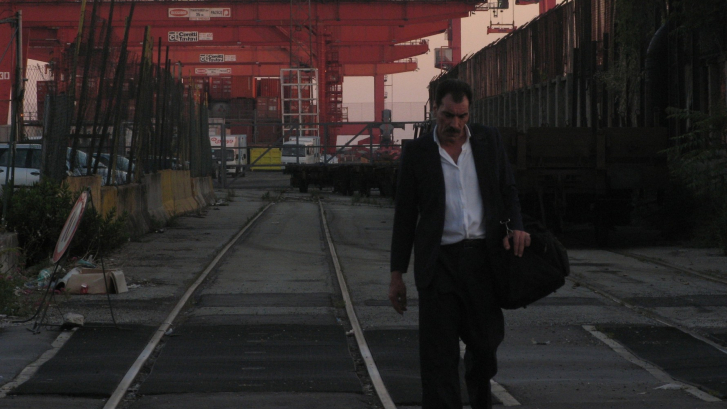La bocca del lupo

Enzo returns to Genoa after 14 years of imprisonment. He goes about the city, which has changed after many years. In a little house in the old town ghetto, his companion Mary waits for him. They exchanged letters and messages while he was away. This poetic portrait of a criminal and his transsexual partner is at the same time a portrait of Genoa, especially the areas shaped by immigrants.
If we never tire of seeing love stories in the cinema, it must be to do with the unfathomable secret of how different times and places play a role in how scripts are written. The love story between the transsexual Mary and Enzo, a Sicilian with a moustache and a heart of gold, started in prison and takes its course in Genoaʼs harbor district, a world that is close to disappearing. Pietro Marcello also sets a parallel plot in the same district, which documents and reconstructs the lives of Mary and Enzo in a simultaneously truthful and fictitious manner. Combining scenes from today and images from the past that Marcello found in various public and private treasure chests, LA BOCA DEL LUPO uncovers a city both melancholy and audacious, where the women at the bars speak in voices nearly as deep of those of the men with whom they drink and where those stranded there have never been able to escape the unreal, forgotten places of the harbor. Itʼs as if Genoaʼs harbor district actually invented the love story between Mary and Enzo. Pietro Marcello has reconstructed this love story in the form of a script for a documentary, which uses distinctive music, memories and archive material to bring a barely visible past back to life.
Genoa, yesterday and today
The idea for this film came from the San Marcellino Foundation, run by the Jesuits of Genoa, who for years have given aid to the homeless, disadvantaged and destitute in various ways. The intention
was to recount not so much the work of the Foundation itself but the world in which it works, the people and the city.
Before I started work on the film I didn’t know Genoa well; the only memories I had were the stories my father told me – being a sailor, he always shipped out from there and throughout his youth, Genoa represented his ideal city. He always told me how beautiful it was, of its tripe markets, which don’t exist any more, and of its sky; a northern town that always looked southward.
I knew a different Genoa. I lived in a part of the city near the port where, like in the majority of northern Italian cities, the social fabric was especially distinct, and where the past is as ingrained as the cobblestones of Sottoripa.
With this film, I tried to talk about the present around me, about the residue from a lost world – while the nostalgia of the 20th century is represented through archive materials of films made by both amateurs and professionals, recorded by the Genoese of the old generation. My outlook on the present is that of a stranger looking out a window and describing what he sees; the outlook on the past and on history is represented by the Genoese who have been able to talk silently via a camera lens.
Pietro Marcello
details
-
Runtime
75 min -
Country
Italy -
Year of Presentation
2010 -
Year of Production
2009 -
Director
Pietro Marcello -
Cast
Enzo Motta, Mary Monaco, Franco Leo, Stefano Carappa, Anna Massa -
Production Company
Indigo Film; L’Avventurosa Film -
Berlinale Section
Forum -
Berlinale Category
Documentary-, Essay Film -
Teddy Award Winner
Best Documentary/ Essay Film
Biography Pietro Marcello
Pietro Marcello was born in Caserta, Italy on July 2, 1976. He studied at the Accademia di Belle Arti in Naples.
Filmography Pietro Marcello
2011 Il silenzio di Pelesjan (Documentary) | 2013 Venice 70: Future Reloaded (Documentary) | 2014 9x10 novanta (Documentary) (segment "L'umile Italia") | 2015 Bella e perduta - Eine Reise durch Italien | 2019 Martin Eden